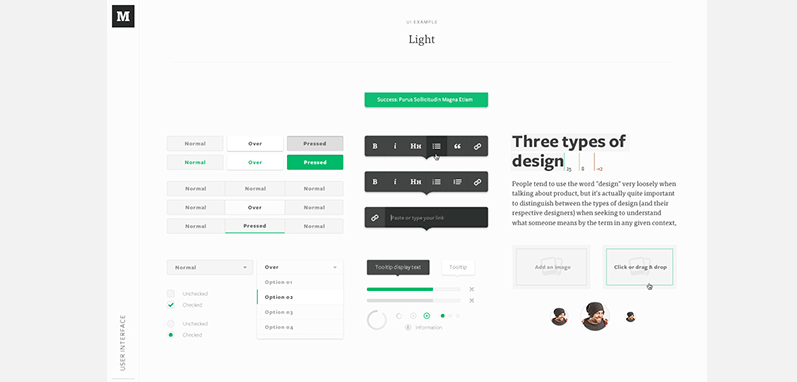Contenu
Qu'il s'agisse d'une entreprise que vous avez récemment créée ou d'une entreprise existante qui avait besoin d'être relookée, la création d'un nouveau site web est passionnante. Cependant, il y a beaucoup de éléments de marque à inclure avant de lancer votre site si vous ne voulez pas que les gens perçoivent votre marque comme négligée ou non professionnelle.
Heureusement, vous pouvez éviter cela en suivant quelques étapes simples. Si vous vous concentrez d'emblée sur les tâches les plus importantes, vous augmenterez les chances de réussite du lancement de votre site.
Dans cet article, nous examinerons l'importance d'élaborer une stratégie de marque pour votre nouveau site web. Nous vous présenterons ensuite cinq tâches clés à inclure dans votre liste de contrôle. Allons-y tout de suite !
L'importance de l'image de marque avant le lancement d'un nouveau site web
Lorsque vous lancez un nouveau site web, on ne saurait trop insister sur l'importance de l'image de marque. La marque de votre entreprise est le fondement de celle-ci. C'est l'identité qui influence la façon dont les consommateurs perçoivent votre entreprise et les attentes qu'ils ont à son égard.
Une image de marque de qualité joue un rôle essentiel dans la réussite marketing de toute entreprise. Mais elle est particulièrement importante pour les nouvelles organisations qui n'ont pas encore établi leur réputation. Votre site web est ce que la plupart des consommateurs utiliseront pour se faire une première impression de votre marque. Vous souhaitez donc qu'elle soit positive.
Création d'un une identité de marque forte peut conduire à un meilleur site web. Une fois que vous avez compris vos valeurs, vos objectifs et votre mission, il devient plus facile de concevoir et de maintenir un site web qui communique votre message avec précision aux visiteurs.
Une liste de contrôle complète pour les nouveaux sites web (5 tâches clés)
Si vous voulez que l'identité de votre marque se traduise efficacement auprès de nouveaux publics, vous devez prendre en compte certains éléments avant de lancer votre site web. Examinons les cinq tâches essentielles à la création d'une image de marque adéquate pour votre nouveau site.
1. Rédiger la déclaration de mission et l'histoire de la marque de votre entreprise
Une déclaration de mission aborde les points suivants quoi, pourquoi, et comment de votre entreprise :
- Ce qu'il faut faire faites-vous ?
- Pourquoi le faites-vous ?
- Comment le faites-vous différemment des autres entreprises ?
Une déclaration de mission claire et fondamentale communique votre objectif. Elle donne à votre entreprise une orientation et vous aide à rester sur la bonne voie.
Outre le fait de maintenir les employés sur la même longueur d'onde, vous pouvez utiliser votre déclaration de mission pour vous démarquer de vos concurrents. En la plaçant stratégiquement sur votre site web, de manière à ce que les utilisateurs puissent la consulter, vous pouvez leur permettre d'établir plus facilement un lien avec votre entreprise :

Lorsque vous rédigez votre déclaration de mission, vous pouvez envisager d'y inclure l'histoire de votre marque. Cela peut ajouter une touche personnelle et humaniser votre marque afin qu'elle trouve un meilleur écho auprès des consommateurs.
Par exemple, vous pouvez jeter un coup d'œil dans les coulisses en expliquant comment votre entreprise a démarré. Vous pouvez également inclure une chronologie des événements importants et des faits marquants de votre parcours.
2. Élaborer une stratégie pour le contenu du site web et du blog
Votre le contenu est d'une importance capitale lorsqu'il s'agit d'attirer et de fidéliser le public. Il influence également l'optimisation des moteurs de recherche (SEO)ce qui est particulièrement important pour les nouveaux sites web.
Avant de lancer votre site web, il est utile de définir les mots clés que vous souhaitez cibler et de veiller à ce qu'ils soient correctement incorporés dans le texte du site, les titres, les descriptions, etc. Il est également recommandé de passer les pages au peigne fin pour s'assurer qu'elles sont rédigées d'une manière qui s'adresse à votre public cible.
Voici quelques questions à se poser :
- Le site web articule-t-il le message de votre marque de manière claire et concise ?
- L'image de marque est-elle cohérente sur chaque page, y compris la langue, le style et la structure ?
- Le contenu est-il précieux et utile, plutôt que strictement intéressé ?
Outre le contenu qui figurera sur le site au moment de son lancement, vous pouvez également envisager de planifier à l'avance l'utilisation d'une un outil de calendrier de contenu tel que CoSchedule:

Ce site web est facile à utiliser et offre une période d'essai gratuite de deux semaines. Vous pouvez l'utiliser pour créer un calendrier de contenu et un calendrier de publication. L'élaboration d'une stratégie de contenu à l'avance peut vous aider à maintenir une diffusion cohérente, ce qui peut renforcer la confiance et la fidélité des clients.
3. Intégrer et aligner votre site web avec les canaux sociaux
Votre marque sociale est également une extension de votre entreprise. Il est donc important de veiller à ce qu'elle soit cohérente avec vos autres plateformes.
Une image de marque cohérente contribue à établir le professionnalisme et la crédibilité. Elle permet également aux utilisateurs de vous reconnaître plus facilement sur les différents réseaux. Il existe de nombreuses façons d'atteindre ce niveau de cohérence, notamment :
- Utiliser le même avatar pour chaque réseau (comme votre logo)
- S'en tenir à la voix de votre marque lors de la rédaction des légendes et des posts
- Incorporer les mêmes couleurs dans les messages et les profils
Jetons un coup d'œil sur Planet Fitness comme exemple de cohérence de l'image de marque. Sur son site web, on trouve une offre bien visible, une forte utilisation du violet et du jaune, et un graphique représentant une femme en train de faire de l'exercice :

Si nous nous rendons à la la page Facebook de l'entrepriseNous voyons ceci :

Bien que les deux plateformes aient une présentation légèrement différente, elles intègrent toutes deux les mêmes éléments. Ce n'est qu'un exemple parmi d'autres de la manière dont une stratégie de marque forte peut contribuer à l'harmonisation de vos canaux.
4. Créer des liens de marque avec PrettyLinks
L'un des éléments de l'image de marque que certaines entreprises ont tendance à négliger est l'établissement de liens. Cependant, l'utilisation de liens de marque est un moyen facile de distribuer des liens optimisés et formatés de manière similaire, quel que soit l'endroit où ils sont partagés ou où ils mènent.
Les liens de marque intègrent le nom de votre entreprise dans l'URL. Ils ont un aspect plus net et sont plus faciles à mémoriser que les liens longs et encombrants. De plus, ils sont faciles à créer, grâce à des outils tels que nos Prise PrettyLinks:

Une fois que vous avez téléchargé et installé notre plugin, vous pouvez l'utiliser pour raccourcir et marquer vos liens directement depuis votre tableau de bord WordPress. Vous aurez ainsi l'esprit tranquille en sachant que chaque fois que vous partagez un lien, cela contribue à renforcer la notoriété de votre marque.
5. Élaborer un guide de style de la marque
Le lancement d'un nouveau site web peut s'avérer chaotique, notamment en raison du grand nombre de questions liées à l'image de marque à prendre en considération. C'est pourquoi il peut être utile d'élaborer un guide de style de marque.
Un guide de style de marque est une ressource contenant les règles, les lignes directrices et les exigences relatives à l'image de marque de votre entreprise. Il documente également les attentes et les critères de présentation de votre marque.
Il existe de nombreux éléments que vous pouvez aborder dans votre guide de style. Guide de développement de la marque Medium présente un exemple des détails et de la profondeur qu'il peut offrir :

Quand création d'un guide de styleEnvisagez d'ajouter des éléments tels que
- Histoire de la marque/déclaration de mission
- Palettes de couleurs
- Variations du logo
- Typographie
- Voix et langage
Régler ces détails avant le lancement de votre site est une stratégie efficace pour renforcer l'image de votre marque. Elle vous permet également de maintenir une expérience cohérente au fur et à mesure que votre entreprise se développe.
Conclusion
Se préparer à lancer un nouveau site web peut être une période incroyablement stressante et chaotique. Cependant, vous n'avez qu'une seule chance de faire une première impression, il est donc important de vous assurer que vous avez couvert toutes les bases de votre image de marque avant de lancer le site.
Comme nous l'avons vu dans cet article, il y a cinq tâches essentielles à inclure dans la liste de contrôle de l'image de marque de votre nouveau site web :
- Rédigez la déclaration de mission de votre entreprise et l'histoire de votre marque.
- Élaborez une stratégie pour le contenu de votre site web et de votre blog.
- Intégrez et alignez votre site web avec les canaux de médias sociaux.
- Créez des liens de marque à l'aide de notre Prise PrettyLinks.
- Élaborer un guide de style de la marque.
Vous avez des questions sur la stratégie de marque de votre nouveau site web ? Faites-nous en part dans la section des commentaires ci-dessous !









Laisser un commentaire